What is frozen shoulder?
A very common condition which is often misdiagnosed. It occurs in 2-5% of the population aged between 40-60 and more commonly women
It is not just a painful shoulder and it also is not just a shoulder that you can not move. It is defined as a global loss of passive movement with normal X Rays.
This means that not only can you not move it but nor can your doctor.
The Xray is of vital importance to the correct diagnosis. This is because the other common cause of pain and stiffness in the shoulder is arthritis.
What happens to the joint in Frozen Shoulder?
The shoulder joint is a ball and socket joint surrounded by layers of skin, fat, muscles, ligaments and tendons that all hold it together and move it around. Those are all normal in a Frozen shoulder but what is not normal is the joint capsule. Normally this is thin and stretchy like Lycra but in a Frozen shoulder something upsets it causing it to thicken and lose its elasticity which in turn causes pain and loss of movement.
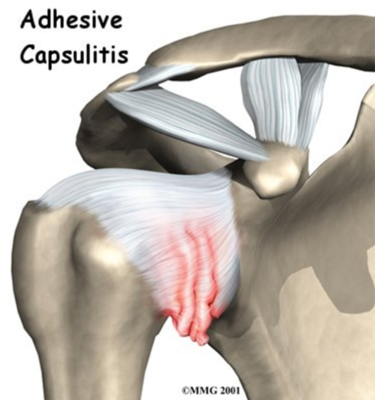
Causes
The trigger is not always clear and may not be result from anything dramatic you have done. Sometimes the trigger is more obvious such as after surgery on the shoulder, arm or chest or after a fall.
People with diabetes and thyroid problems have a slightly higher risk.
A thorough and careful assessment is important because frozen shoulder is commonly misdiagnosed as being a rotator cuff tear. And likewise people who have rotator cuff tears are often told they have frozen shoulder. It is important that patients who are thought to have either condition be properly diagnosed in order to get the correct treatment.
Diagnosis
The early stages of Frozen shoulder can be hard to diagnose as many of the symptoms are identical to tendonitis i.e painful on movement but it still moves reasonably well.
The main symptom is PAIN
This is called
Stage 1 or the Freezing stage.
About 75% of people who are told they do not have a frozen shoulder do in fact have it. By the time you consult your GP or a consultant the condition may have progressed to the Frozen stage.
The Frozen stage
This is when the shoulder will simply not move. You can test this by lying down on the floor and stretch both arms up over your head. The non affected arm will be able to touch the floor whereas the affected arm will be some way away.
Another test is you tuck your elbows in to your side and keeping them there with elbow bent to 90 degrees rotate the hand out away from the body. You will see a big difference in the range.
Thawing
This is the final stage where the capsule slowly recovers and the functional movement returns.
How long will it take?
If the shoulder is not too painful and is not preventing you sleeping and doing everyday chores then you may chose to live with it and wait until it settles. This may take some patience but left alone most Frozen shoulders get better on their own but can take anything up to 18 months.
Treatment
If it is very painful in either the early stages or Frozen phases then an injection in to the joint is worth a try. If nothing else it may relieve the pain and the stiffness will resolve later. The injection may also change the progression of the condition and trigger a rapid defrost which would be very helpful.
In some cases, when the stiffness is so severe that you can not lead a normal life, then a manipulation under anaesthetic (MUA) could be performed.
The best time to do the MUA is when the shoulder has fully frozen up and not before. If you are operated during the freezing phase then the risk of re-freezing is higher. It may start off well after the surgery and then freezes up again. So that is why injections are suggested in the early phase.
In cases with significant pain and stiffness, an injection of a corticosteroid medication into the joint often is recommended.
The injection into the joint is a very different sort of injection to the one either a GP might give you or that might be given for tendonitis. It is a steroid injection but it goes right into the joint where all the freezing activity is actually taking place. It is usually done by a radiologist ( a Consultant specialising in imaging) in the X-ray department and they use either the Ultra-sound scanner or an Image Intensifier (a moving x-ray machine) to guide the needle into the right place. For NHS patients it may be offered as a day-case in the operating theatre with you lightly sedated.
However, once the shoulder is fully frozen then they do not have any effect.
Stiffness that lasts beyond a full course of physiotherapy over six to 12 months or shoulder stiffness that gets significantly worse during physiotherapy may signal that the surgery is needed to release the tight ligaments and remove scar tissue that may contribute to the problem.
The surgery usually can be done arthroscopically through two to three small incisions as an outpatient procedure, so an overnight hospital stay is not required.
Physiotherapy is still necessary for several weeks or more after surgery to prevent frozen shoulder from coming back.
After it has been successfully treated, it is uncommon for frozen shoulder to return in the same shoulder. But some patients may go on to have it in the other shoulder.
In people who have medical issues that put them at risk for the condition, treating the underlying disorder may decrease the likelihood of developing frozen shoulder.
What can I do myself to help the pain?
Self help is normally the best form of treatment – full recovery for this condition may take a long time. The aim of treatment is to ease pain and stiffness and keep the movement of the shoulder as good as possible whilst encouraging the condition to clear.
1. Medication – Anti-inflammatory tablets or painkillers may have been prescribed or alternatively can be purchased from a chemist. These may help with stiffness and pain but may not be suitable for all patients. Paracetamol may be a suitable alternative. If in doubt you should consult your GP or pharmacist before taking any medication.
2. Heat – This may be useful. Use a wheat bag or hot water bottle wrapped in a towel for 15 minutes as often as required. Ensure the pack is not too hot to avoid burning the skin.
3. Ice – Some people find ice more helpful than heat. Apply a cold pack for 15 minutes to the affected shoulder. You may repeat every 3-4 hours. Do not apply the ice directly to the skin (place a damp cloth between your skin and the ice to avoid ice burns).
4. Pillows – Adopt a comfortable position. Lying on the unaffected side with a pillow under the affected arm can be comfortable. You may also place a pillow behind you whilst on your side to prevent you from rolling over.
5. Exercise – Gentle exercise is advised to maintain available range of movement during all 3 stages of the condition and encourage a successful recovery of any lost movement as the condition resolves.
Exercises/ Physiotherapy
Exercise is advised to maintain available movement during all 3 stages. Initially these should only be performed within the boundary of pain. There may be some level of discomfort while exercising.
If discomfort increases after completion of the exercises then reduce the number of repetitions of the exercises but do not stop altogether.
If you have associated pain from the neck and back the physiotherapist will also be able to help you with this.
A physiotherapist will come in to their own once you reach stage 3 or after surgery. They can provide exercises to help restore the full range of motion and mobility.
They will help stretch all the tight structures and give you a graduated exercise program for you to perform at home.
They will be paramount in restoring the shoulder back to full strength and mobility.
Some examples of Early exercises are below:
1. Pendular exercises
Stand leaning forwards fully supported with the unaffected hand. Let the affected arm hang down, let it relax. Gently swing your arm backwards and forwards, side to side, and in circles.
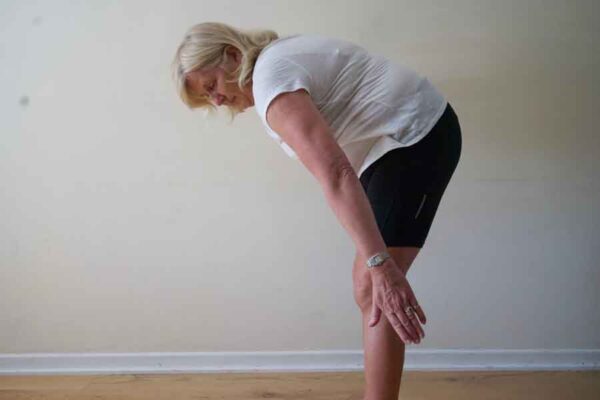
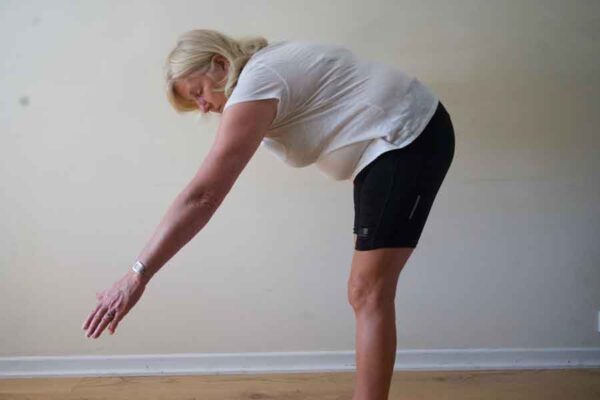
2.Double arm lift
Lying on your back, put both your hands together or hold a stick and keeping your elbows straight.
Lift both arms over your head, as far as you can keeping it as close to the ear as possible.
Repeat up to 10 times. Do 2–3 times a day.
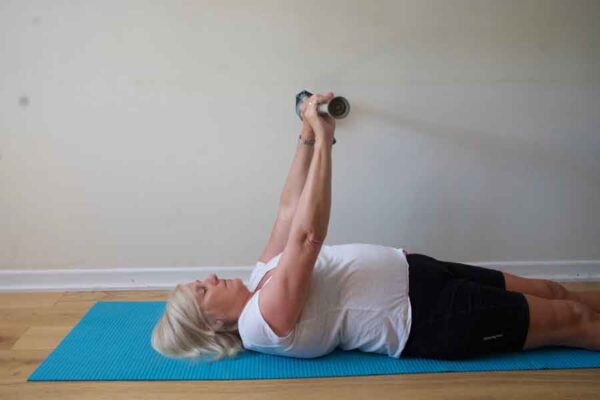
3. Shoulder rotation
Stand with your elbows bent to 90◦ holding a stick in front of you or you can do in lying.
Gently push the stick sideways across your body. Keep your elbow tucked into your side, feel the stretch in the shoulder.
Hold for 20 – 30 seconds. Repeat 5 times, 2-3 times per day.
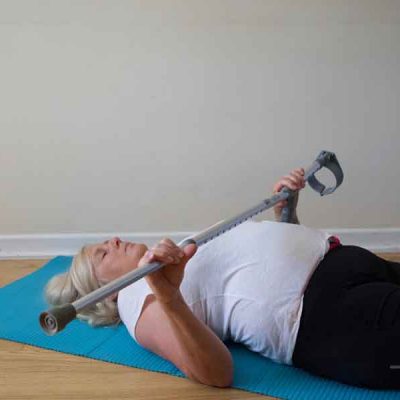
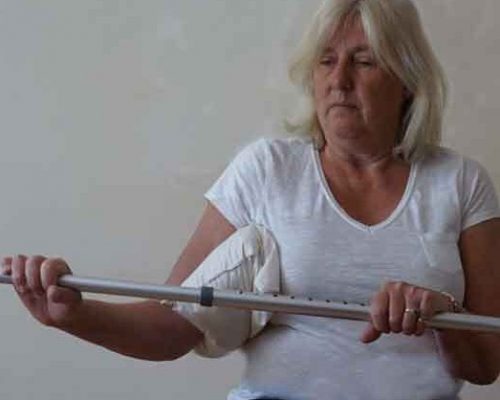
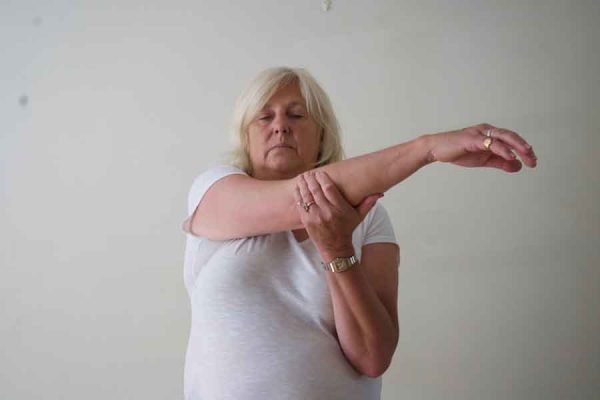
The following exercises may be helpful in stage 3 as the condition improves.
1. Stand or sit. Stretch one arm over the opposite shoulder by pushing it at the wrist with your other arm. Hold the stretch for approx 20 – 30 seconds then relax.
Repeat 5 times
2-3 times per day.
Towel exercise
Stand or sit. With one arm bring a towel over your shoulder behind your back. Hold the towel as shown. Gently pull upwards stretching the affected arm behind your back. Hold for approx 20 – 30 seconds. Repeat 5 times, 2-3 times per day.
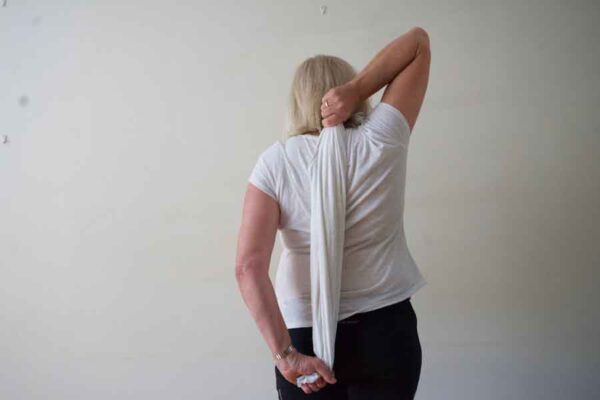
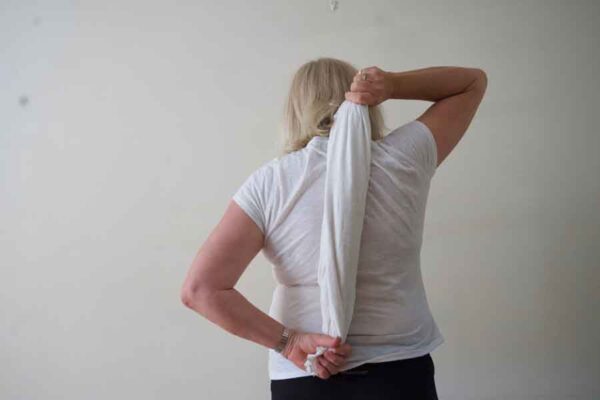
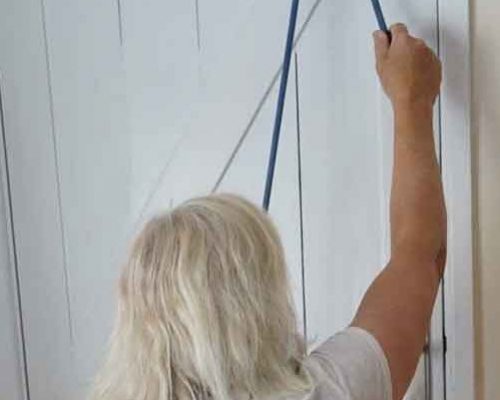
Pulley
Set up a pulley system with some rope over a high object such as coat hook.
Pull down with good arm to get bad arm to lift up higher
Wall slide
Stand by a wall and slide your arm up the wall as far as you can and repeat x 10-20
Then lean into the wall and feel the stretch under the arm pit.Repeat x 5
There are plenty more exercises on this site- visit the link here
Shoulder Exercises- mobilising exercises
If you like the water there are also exercises for the shoulder in water

